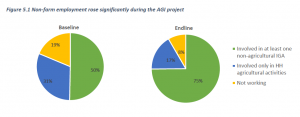The Adolescent Girls Initiative: Rwanda

Rwanda
In the World Economic Forum’s 2020 Global Gender Gap report, Rwanda ranks as the ninth most gender equal country worldwide, placing it as the only African country to be in the top ten. Rwanda is also the country with the largest female-majority in parliament with over 60% female representation. According to the 2014 Demographic and Health Survey, Rwanda’s GDP has been steadily growing at 8% since 2001 and GDP per capita has tripled between 2001 and 2014. Despite this, 39% % of the population is currently living below the poverty line, unable to afford a basket of basic goods. Additionally, due to ramifications of the 1994 Tutsi genocide, 43% of Rwandans are under the age of 15 and 24% of girls aged 15-19 have experienced gender-based violence. As such, both the Rwandan government and international aid organizations have emphasized the need to provide vocational training to youth, particularly to young girls.
Adolescent Girls Initiative
In 2012, the World Bank implemented the Adolescent Girls Initiative in Rwanda with the goal of providing adolescent girls with vocational training and increasing employability.The intervention resulted in:
- a doubling of average income from approximately 5,400 RwF to 10,200 RwF
- a 25% increase in employment
- an increase in livestock ownership from 15% to 44%
- a 20% increase in decision-making power

To achieve these outcomes, the initiative provided vulnerable Rwandan girls, aged 16-24, with vocational and life skills training over the course of a year. The first two weeks were an ‘induction period’ in which participants were given forty hours of life skills training and twenty hours of entrepreneurship skills training. Following the two-week orientation process, the participants spent six months in technical skills training in their respective trade. The girls were given their choice of trade from: food processing, agri-business such as bee keeping, culinary arts, and arts and crafts. Upon completion of the six-month training period, the project managers continued to support participants for the remaining five and a half months of the year by mentoring them, assisting in job placement and cooperative formation, identifying market opportunities, developing business plans, and assisting in the accessing of financial services.

Despite the overall positive results of the Adolescent Girls Initiative, there was also an increase in reported accounts of gender-based violence by 18%. The key issue in evaluating this program is determining whether this increase represents an increase in instances of violence, an increase in reporting, or a combination of the two. Based on analysis of other controversial and uncomfortable survey questions, it appears to be mostly due to an increase in reporting. However, this is impossible to completely determine because the same group of girls was surveyed both before and after the project; there is no control group.
Recommendations
- refine survey questions of the AGI to better reflect DHS survey and ensure accuracy and precision
- add a control group should the AGI run again
- learn from AGI implementations in other countries
- adapt the job training to best suit jobs that are in high demand in the Rwandan economy
- partner with existing women’s councils and cooperatives in the districts to provide vulnerable girls with a supportive environment, socially and economically
.